United States of America
16"/50 (40.6 cm) Mark 7
Pictures
Updated 20 July 2009
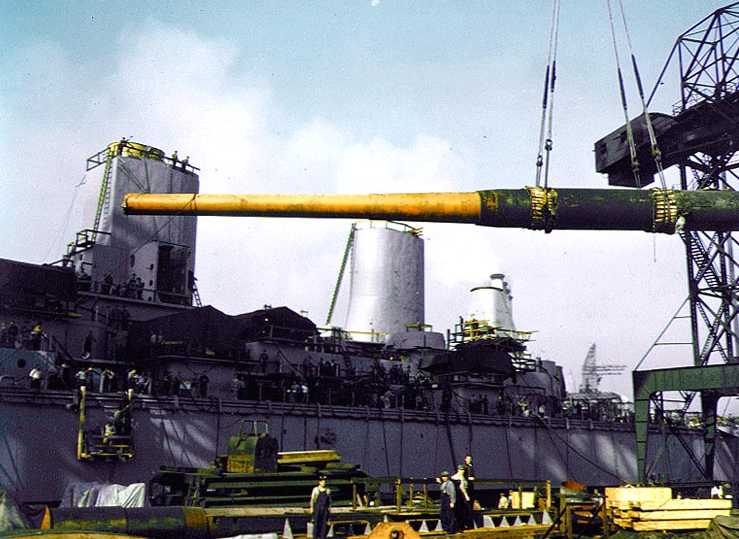
16"/50 (40.6 cm) Mark 7 Gun being lifted
aboard USS Iowa BB-61 in 1942
Note the other guns waiting to be hoisted
U.S. Naval Historical Center Photograph
# K-513
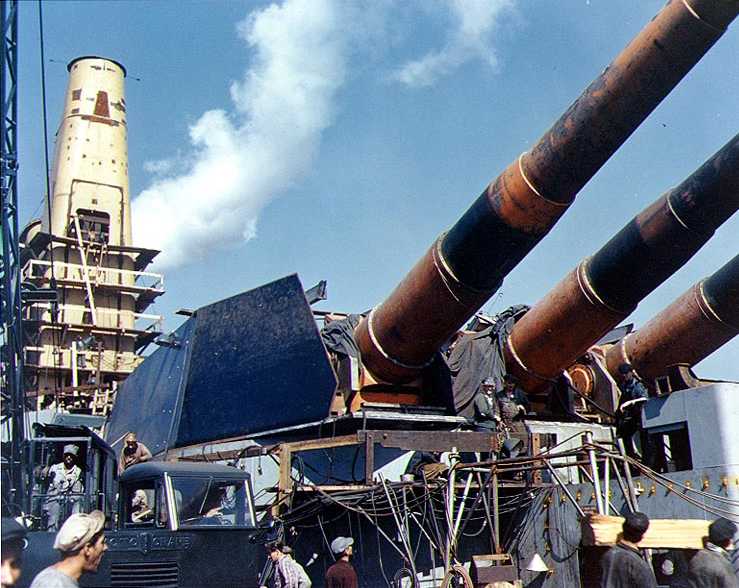
A forward turret being constructed aboard
USS Iowa BB-61 in 1942.
Note the 0.75 in (1.9 cm) STS steel plates
making up the gun house sides. To this will be bolted 9.5 in (24.1
cm) Class A armor plates. The turret back was 0.75 in (1.9 cm) STS
over which was 12.0 in (30.5 cm) of Class A armor plate. The turret
face, not yet in place in this photograph, was made up of 2.5 in (6.4 cm)
STS steel over which was 17.0 in (43.2 cm) of Class B armor plate, equivalent
to a single plate 18.75 in (47.6 cm) thick. The turret roof was 0.75
in (1.9 cm) STS over which was 7.25 in (18.4 cm) of Class B armor plate.
Note the tower foremast in the background.
U.S. Naval Historical Center Photograph
# K-515
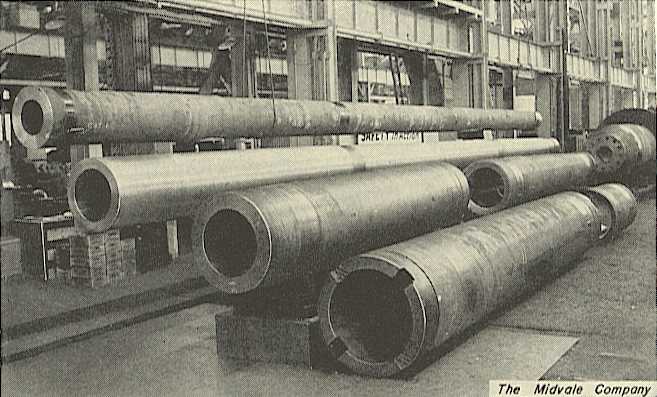
16"/50 (40.6 cm) components
From left to right: Liner, A tube,
jacket and hoops
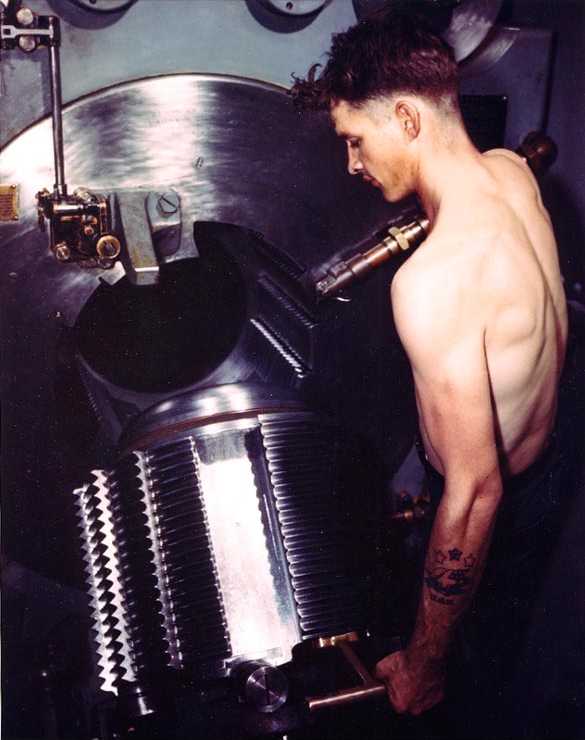
Open 16"/50 (40.6 cm) Mark 7 breech on
USS Missouri BB-63
Note the staggered threads, typical of
a Welin Breech design
U.S. Naval Historical Center Photograph
# 80-G-K-4558
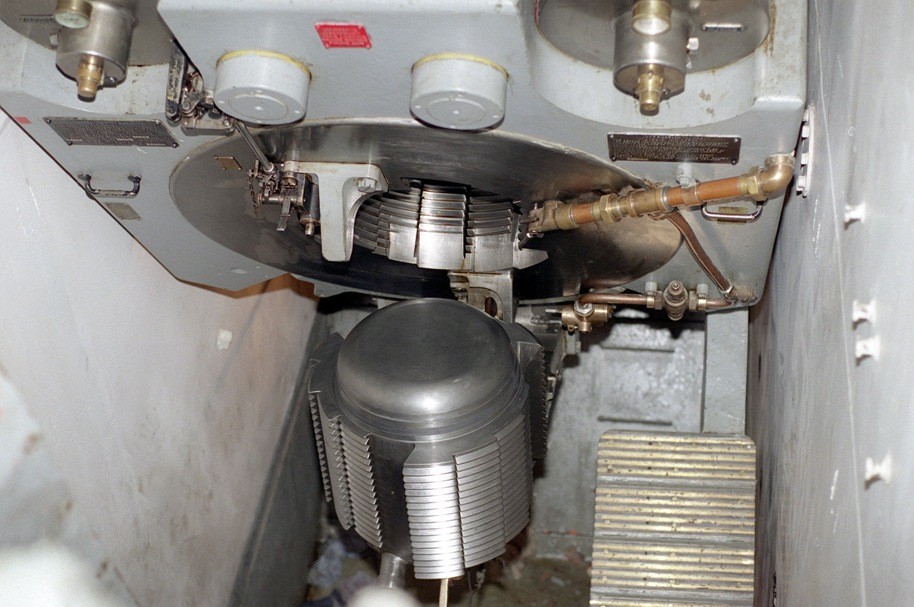
Another view of an open breech plug, this
one aboard USS Missouri BB-63 in February 1985
Note the undercut threads on the lower
part of the breech, which allowed easier plug removal
U.S. Navy Photograph DN-SC-86-00815
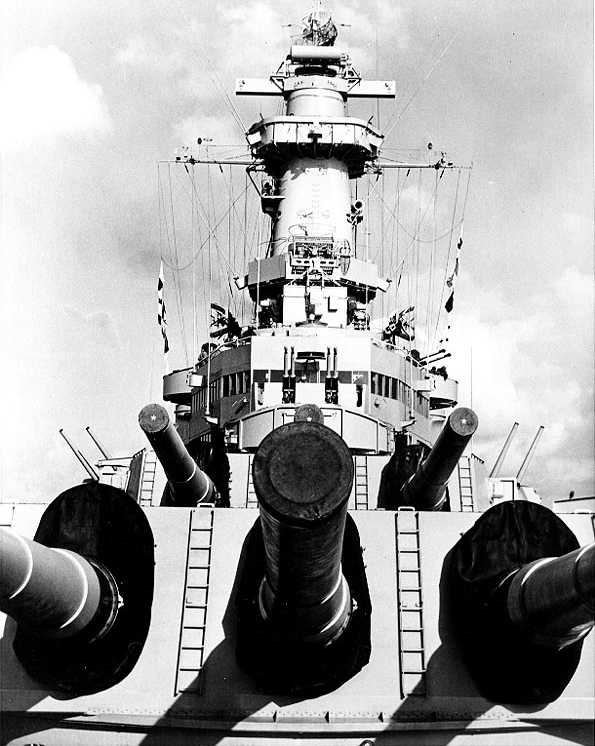
USS Wisconsin BB-64 in March 1952
Note the 40 mm Bofors atop Turret II and
that the forward Mark 37 secondary director is facing astern
U.S. Naval Historical Center Photograph
# 80-G-441039
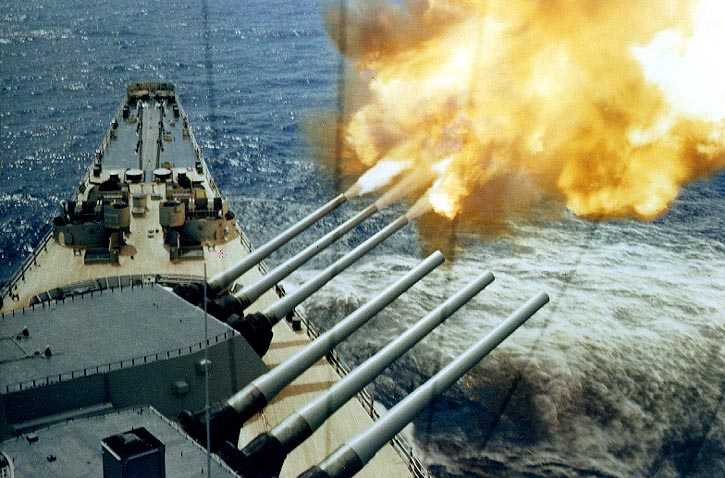
USS Wisconsin BB-64 in January 1952
The same guns as in the above picture
firing a salvo off Korea
U.S. Naval Historical Center Photograph
# 80-G-K-12103
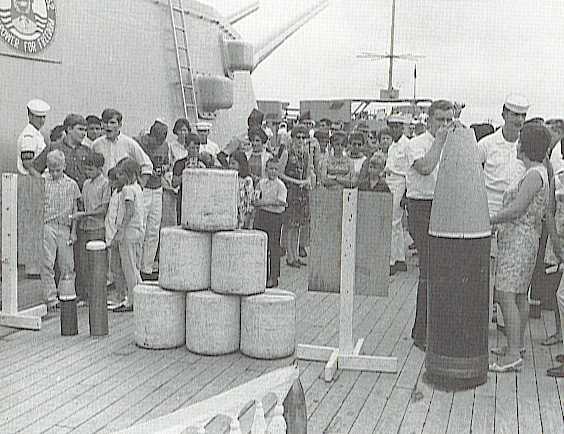
16" (40.6 cm) powder bags and projectile
during open house aboard USS New Jersey BB-62 in 1968
Note the 5"/38 (12.7 cm) projectile and
propellant casing on the left
U.S. Navy Photograph
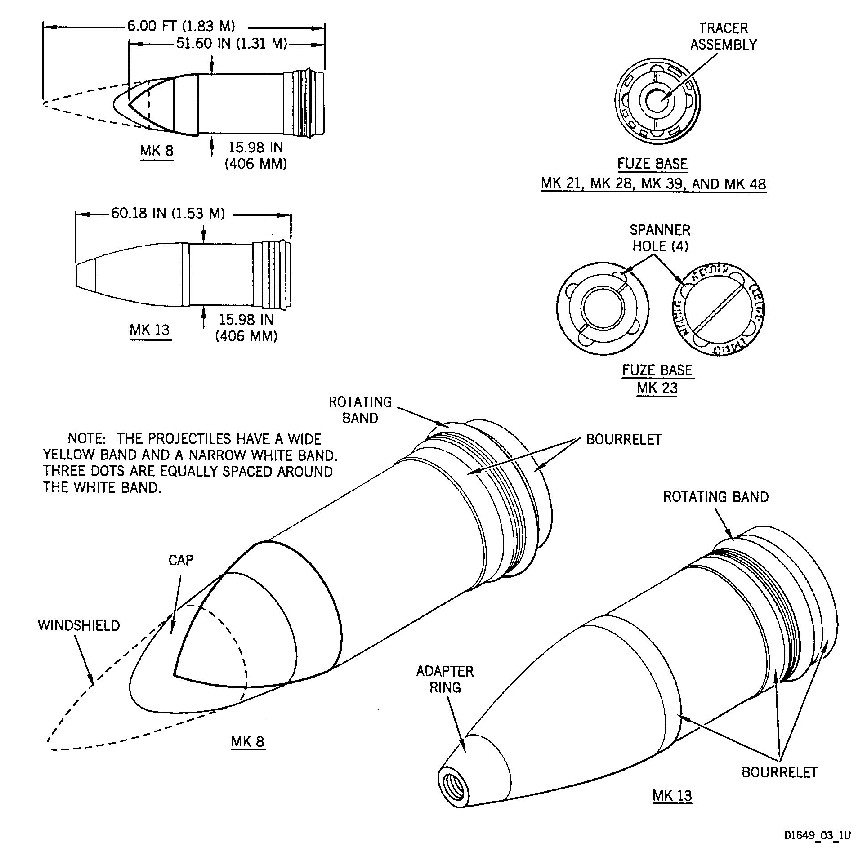
Comparison of AP Mark 8 and HC Mark 13
Note that the Mark 13 lacks a nose fuze
which would add nearly 4 more inches (10.2 cm) to the overall length of
this projectile
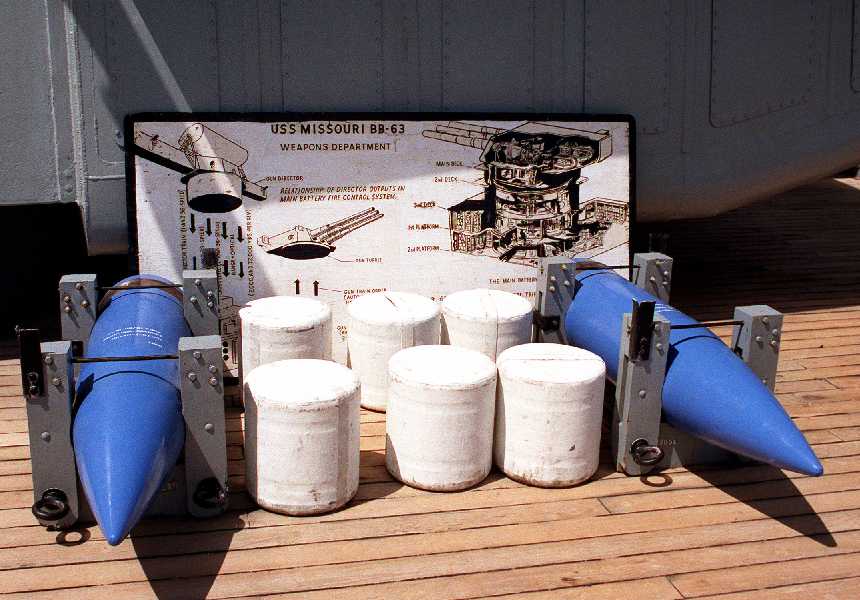
Display of Target Projectiles and dummy
Powder Bags aboard USS Missouri BB-63 in 1991
U.S. Navy Photograph DN-SC-92-02871
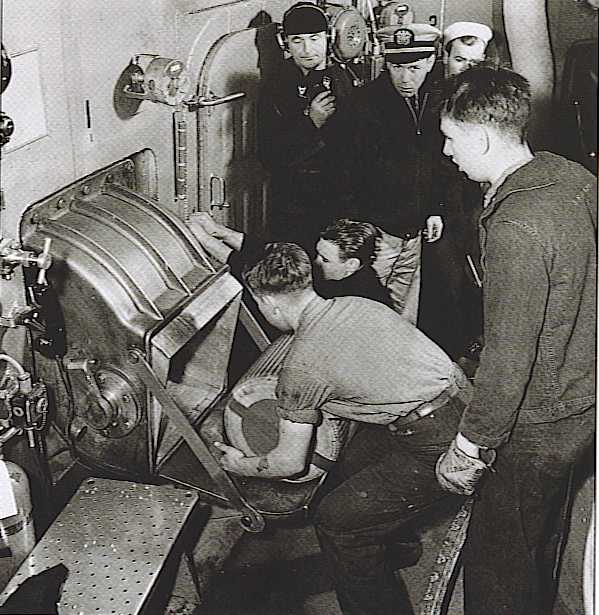
Loading a powder bag into a scuttle on
USS Iowa BB-61
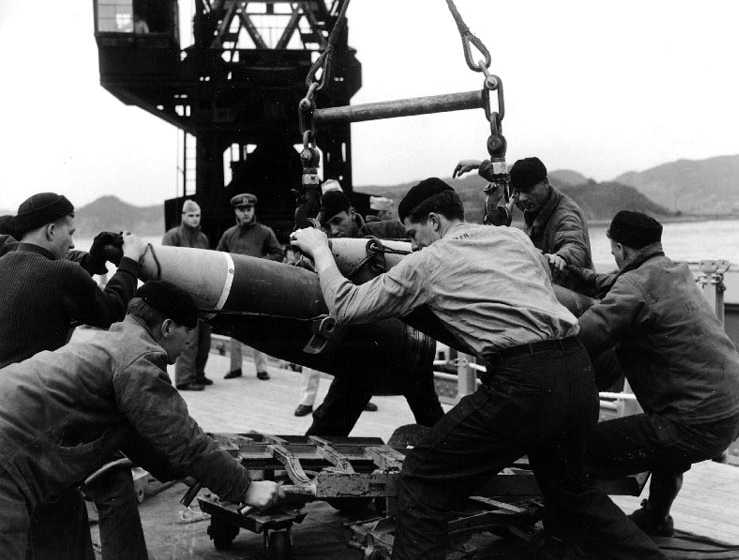
Loading projectiles on USS Missouri BB-63
in 1951
U.S. Naval Historical Center Photograph
# NH 96784
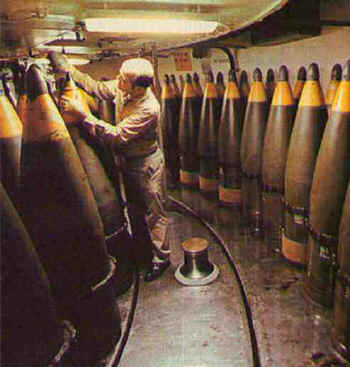
Inside the barbette of USS Iowa BB-61 after
her recommissioning in the 1980's
The Petty Officer is removing the fuze
protective cap from an HC Mark 13. Note the capstan at his feet,
used for parbuckling (moving) the projectiles to the shell hoists.
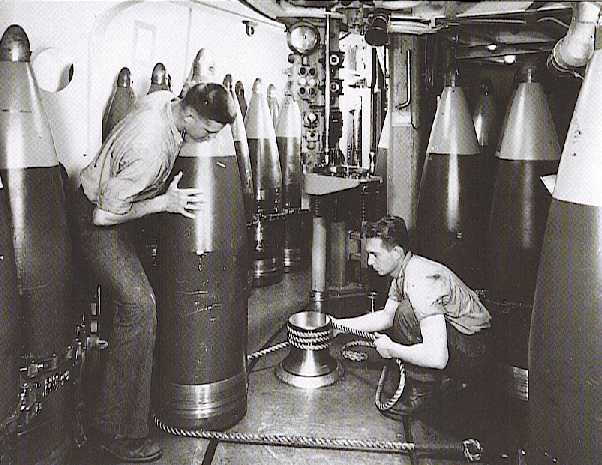
Parbuckling an HC round on USS New Jersey
BB-62
The next four photographs show the loading
and firing of a HC round on USS Iowa BB-61 on 14 December 1986
The "1,000 USS IOWA" stencil is a reference
to this particular projectile being the 1,000th round fired by Iowa's 16
inch (40.6 cm) guns since the ship's recommissioning
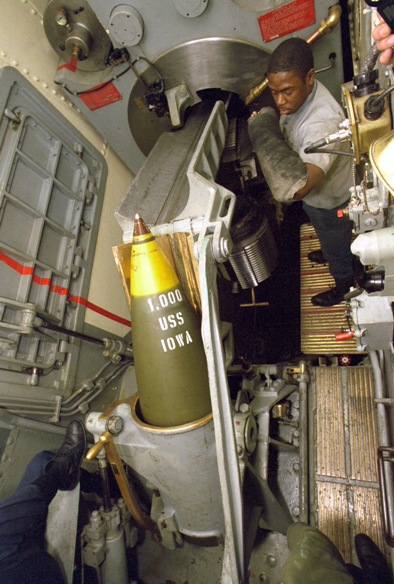 ....
....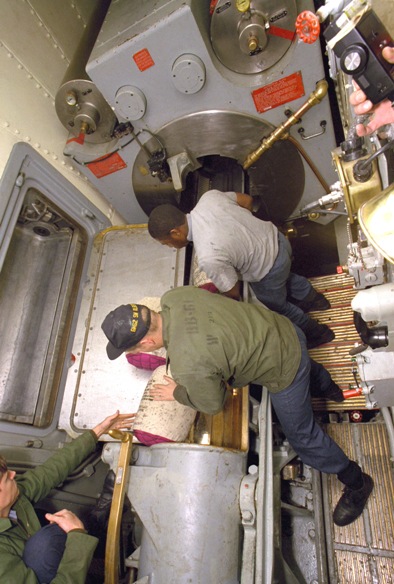
In the left photograph, note the the gauntlet
on the gunner's left arm which is used to wipe down the gas check pad when
the breech opens. This photograph shows that the rammer goes through
the projectile bucket, that the projectile is delivered vertically and
then tipped horizontally in the gunhouse, that the breech plug opens downwards
and that the rammer tray is hinged. Red stripe on the left bulkhead
indicates the limit of the gun recoil.
The propellant bags are delivered by the
powder hoist to the door on the left, which opens to provide a ramp down
which the bags are rolled, three bags at a time, as shown in the right
photograph.
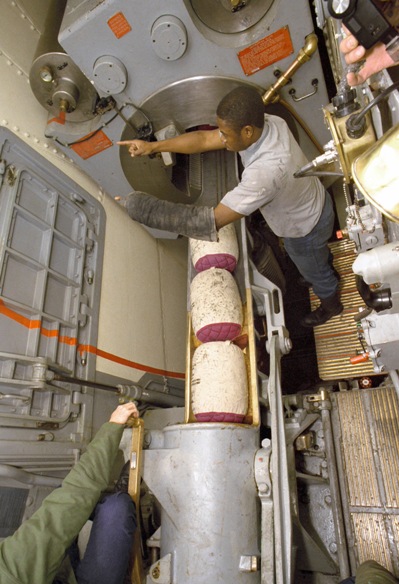 ....
....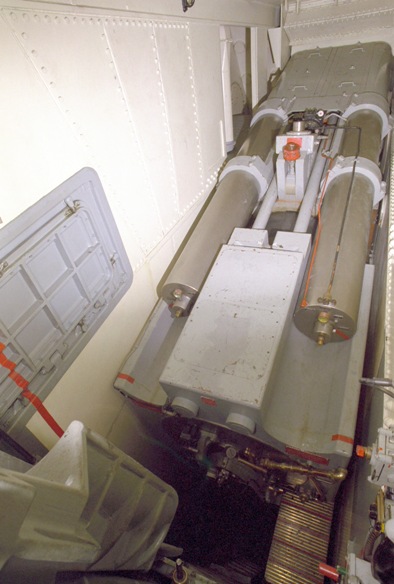
In the left photograph, the gunner is pointing
to the door to indicate that he is ready for the next three bags, which
will be interspersed among the first three bags. All six bags were
normally rammed together into the breech with a single rammer stroke, but
during testing during the 1980 deployments, bags were occasionally rammed
three at a time. The red quilted primer patch on the end of each
bag holds the black powder igniter. The bags in this photograph appear
to be reduced charge bags, which are smaller than full charge bags.
Full charge bags may be seen in the photographs further above.
In the right photograph, the gun is shown
as it fires and about two-thirds of the way through its recoil
Note that in these photographs that the
recoil cylinders appear oval shaped and of different sizes. This
is simply the result of the photographer using a fish-eye lens, as both
cylinders were actually round and of equal size.
The arrangements for the 16"/45
(40.6 cm) Mark 6 guns used on the North Carolina BB-55 class and South
Dakota BB-57 class were nearly identical.
U.S. Navy Photographs DN-SC-91-03642, DN-SC-91-03643,
DN-SC-91-03644 and DN-SC-91-03645

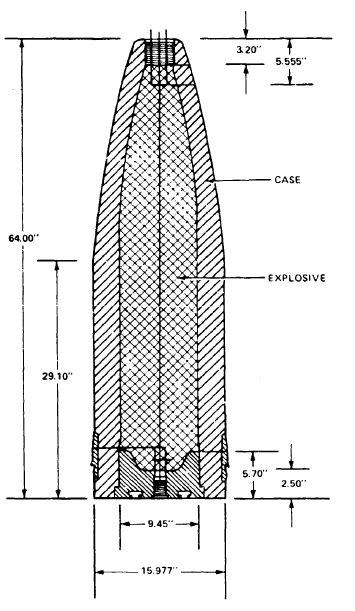
Cross-section of HC Mark 13 projectile
The overall length given in this sketch
is incorrect, it should be 60.18" (152.86 cm). 64.00" (162.56 cm)
was the length including the nose fuze.
Note that the case wall thickness is greater
than 3" (7.6 cm)
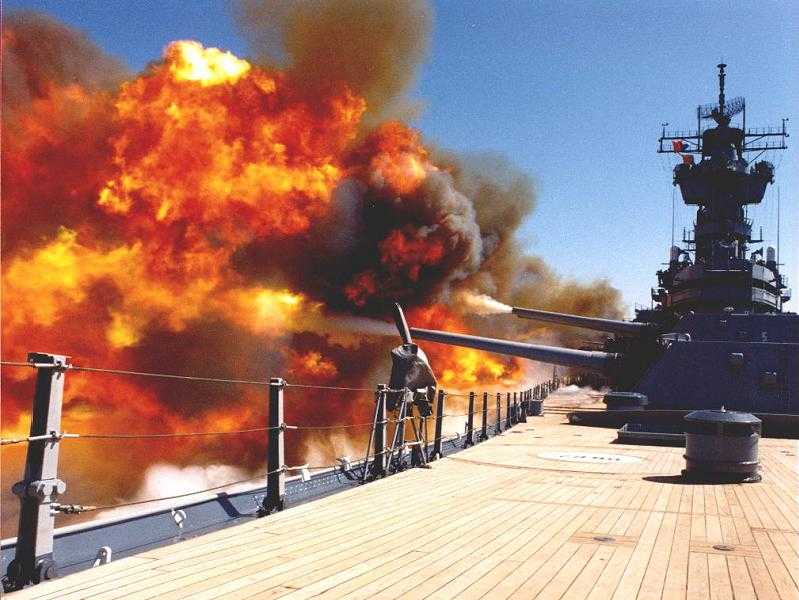
USS New Jersey BB-62 off Australia in 1990
Picture Courtesy of Mick Morris
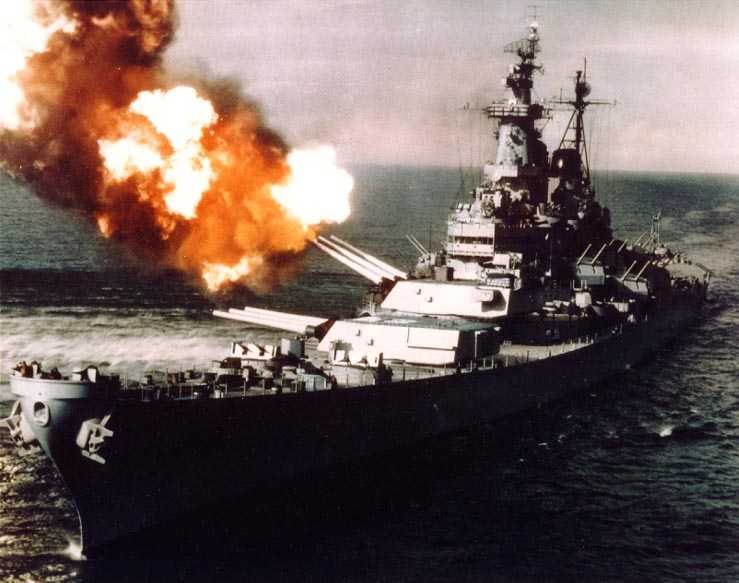
USS Missouri BB-63 in 1950 firing on Chongjin,
North Korea
U.S. Naval Historical Center Photograph
# K-12603
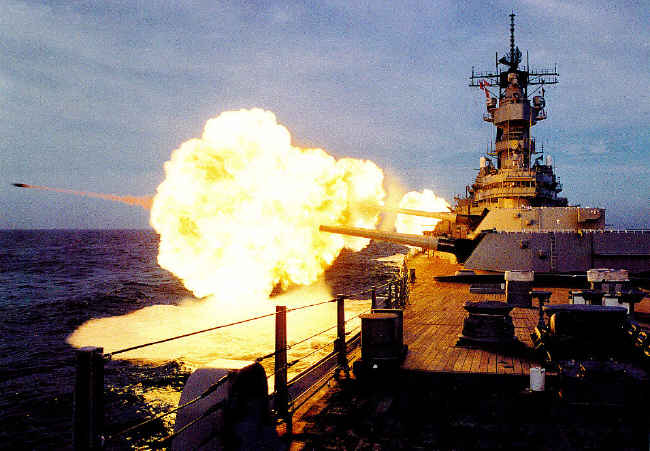
USS Missouri BB-63 firing in the 1980s
Photograph courtesy of Herbert Fahr, President
of USS Missouri Association
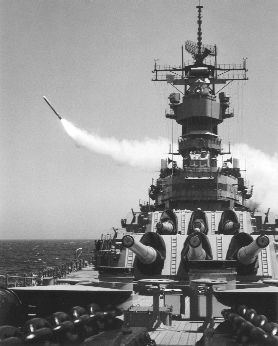
USS Missouri BB-63 firing Tomahawk Cruise
Missile
Photograph courtesy of Herbert Fahr, President
of USS Missouri Association
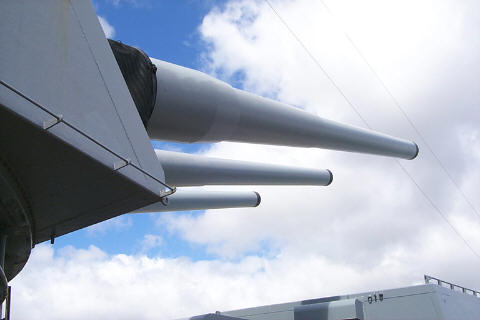
Looking up at Turret II on USS Missouri
BB-63
Picture copyrighted by Jed Clear
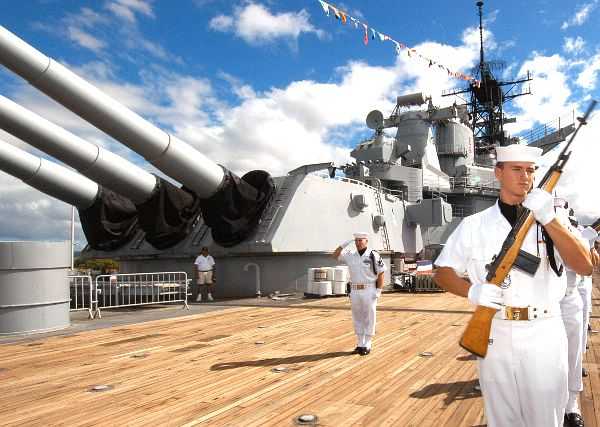
Ceremonial honor guard prepares to render
a 21-gun salute at the 59th anniversary ceremony of the end of World War
II aboard the battleship USS Missouri BB-63 Memorial on 2 September 2004
Sailor nearest the camera is holding an
M-14 rifle
U.S. Navy Photograph 040902-N-3019M-014
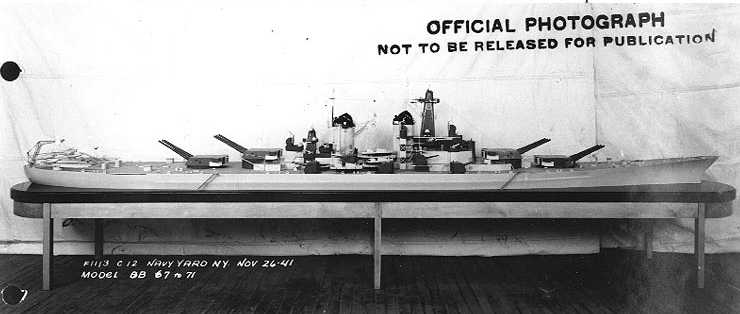
Model of USS Montana BB-67 in 1941
Note the lack of AA weapons in this pre-war
model
U.S. Naval Historical Center Photograph
# NH 93912
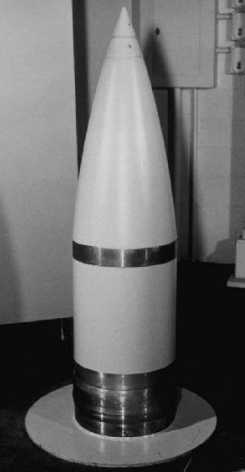
Deactivated Mark 23 Nuclear Projectile
now at the National Atomic Museum in Albuquerque, New Mexico
Photograph copyrighted by Department of
Energy
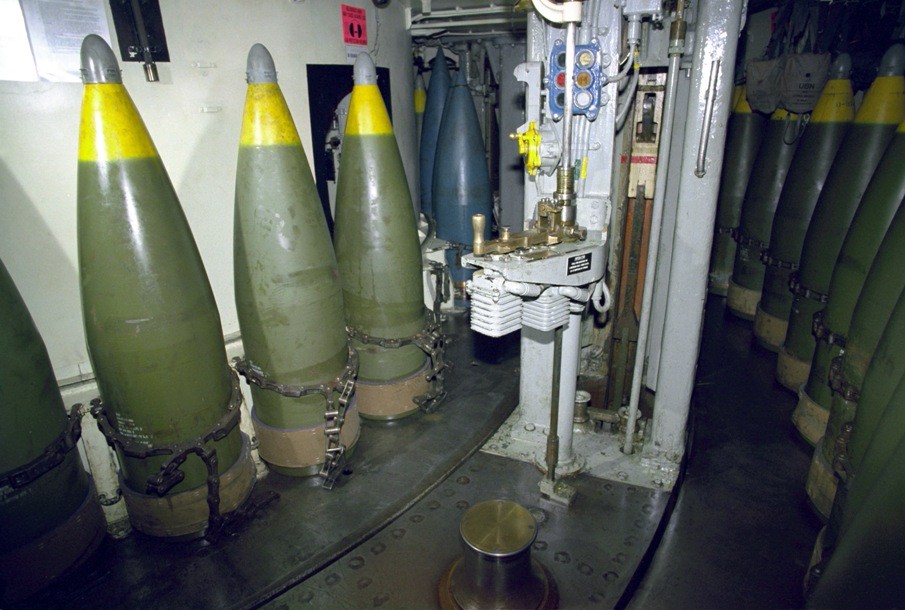
HC Projectile stowage on USS Iowa BB-61
in December 1986
In the background are two 1,900 lbs. (862
kg) and one 2,700 lbs. (1,225 kg) blue Target projectiles
U.S. Navy Photograph DN-SC-91-03635
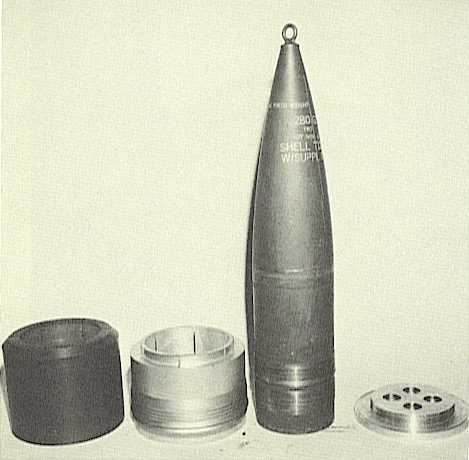
Disassembled "Gunfighter" saboted projectile
of the late 1960s
From left to right: Front Rider,
supporting sabot, 280 mm (11") projectile, and obturator
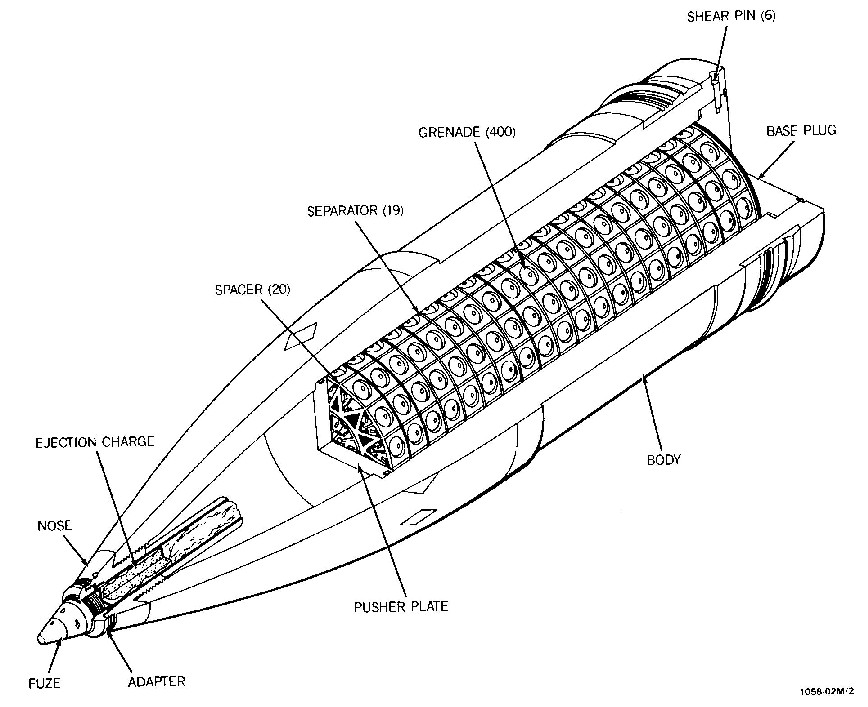
Sketch of Anti-Personnel Improved Conventional
Munition (ICM) Mark 144
Note the lack of a base fuze. When
the nose fuze fired, the resulting detonation of the ejection charge sheared
off the base retaining pins and pushed out the base plug, thus allowing
the grenade bomblets to disperse.
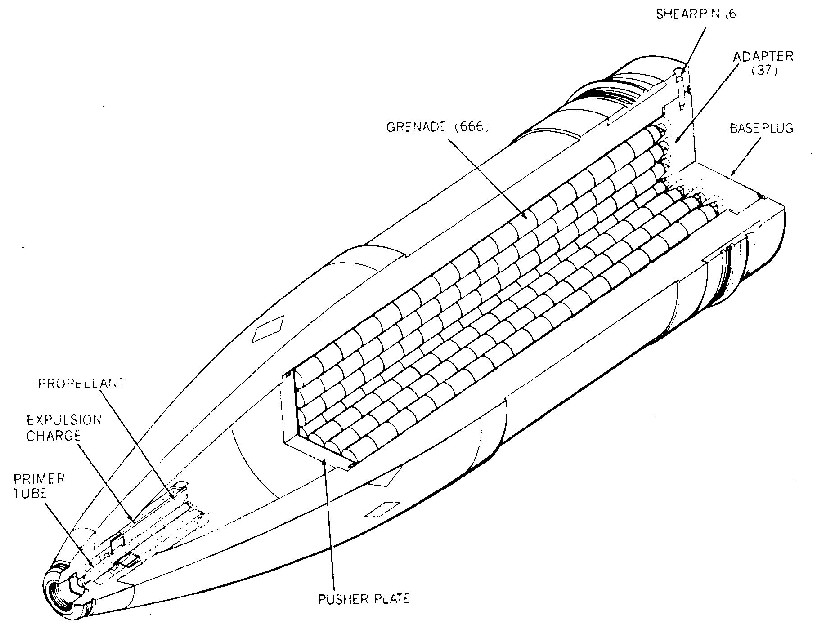
Sketch of Anti-Personnel ICM Mark 146
This projectile did not enter service
|
Advanced
Gun Weapon Systems Technology Program
16/11
Inch Long Range GPS Concept with Sabot

| Sabot Diameter |
16 in (40.6 cm) |
| Projectile Diameter |
11 in (28 cm) |
| Range |
100 nm |
| Launch Weight |
650 lbs. (295 kg) |
| Fly Away Weight |
525 lbs. (238 kg) |
| Launch Length |
69 in (175 cm) |
| Payload |
175.2 lbs. (79.5
kg)
248 M46 Submunitions |
| Guidance Modes |
GPS & INS |
|
Image and data courtesy of United States
Naval Fire Support Association (USNFSA)
Page History
29 November 2008 - Benchmark
20 July 2009 - Added pictures of Mark
144, Mark 145 and comparison of AP Mark 8 and HC Mark 13














 ....
....
 ....
....














